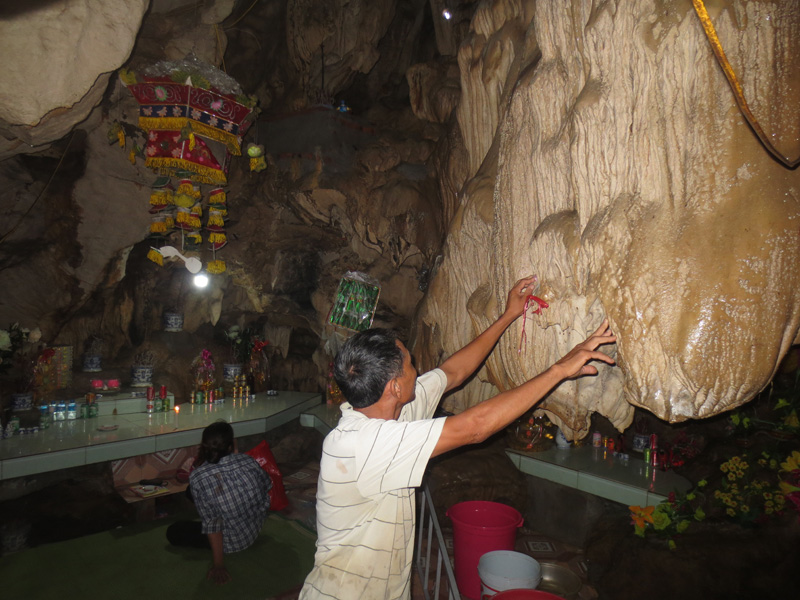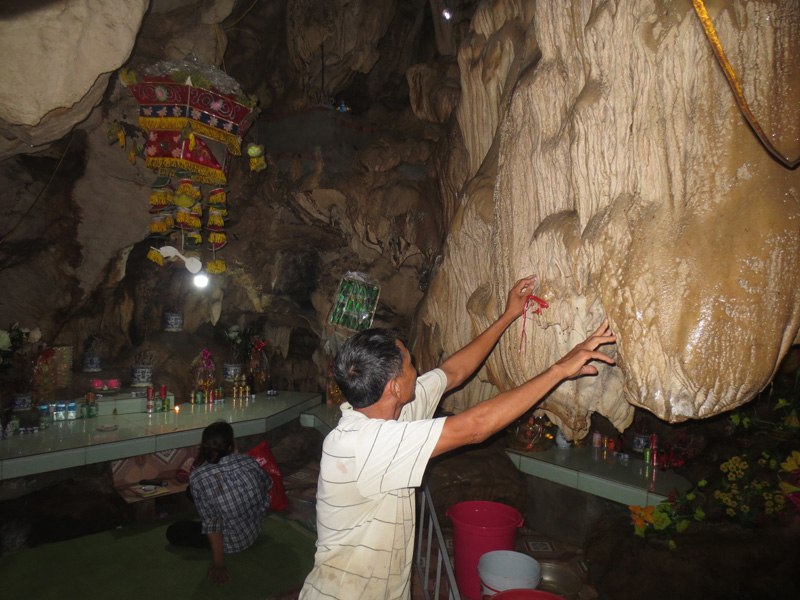
(HBO) - Ngoc Luong commune (Yen Thuy) is not only famous for smooth and flexible Cheo’s rhythm but also a lot of beauty sceneries with the mysterious cave system. Hum Cave is a cave containing many beautiful stalactites created by nature for millions of years, along with the system of worshipping the sacred Buddha in the cave to create the attraction for those who love discovering the natural mystery.

People exploiting the mysterious beauty of Hum cave in Ngoc Luong commune,
Yen Thuy district.
Hum cave belongs to the Nghia
mountain complex in Nghia village, Ngoc Luong commune, Yen Thuy district. The
cave is located at the altitude of about
20 meters above the
field. The cave is known as a majestic hall for Nghia pagoda to lean on. The
cave is created with two interconnected entrances, one in the northeast and one
in the northwest.
From the northeast entrance, you
can see a large green field. Hum cave has the total length of about
100 meters, including
the side niche. The entrance has the width of
1 meter, the height of
0,8 meter and is divided
into 2 floors; you have to spleen through the first floor to the second one,
where can then be spleened through a small niche of
0,6 meter in diameter to
the first arc grotto. This is the stopover for the tourists to discover the
beauty of the cave before exploring the deep interior. When reaching the room,
the visitors will feel fresh and cool. There are a lot of stalactites on the
two sides which are dripping to welcome guests.
Going deep into the cave, tourists can admire
the real world as well as many virtual shapes. Looking at the right side of the
cave wall, we can be surprised at many stalactites with vivid and funny images
like thousands of shapes and appearances of flowers, leaves, trees, birds and
wild animals. All seems to move around. The stone is no longer idle but turns
into the animals with a sense of mind and soul according to the imagination of
the visitors. On the cave arc, the stalactites are dripping like the arrows for
hunting wild animals of the ancient Muong ethnics.The droplets at the top of
the stalactites are shining like glittering stars to erase the dark space in
the cave when the light is shining at them.
Large and small series of
stalactites are like in a natural drawing with brilliant colors and have many
different shapes depending on the people’s imagination. This makes us feel like
walking in a lively world together with hidden creatures turning to stones in
millions of years.
Ms. Nguyen Thi Thao, the guardian
of Hum cave said: At the beginning of spring or on the lunar first and
fifteenth day, Ngoc Luong people, especially the guardians, often visit the pagoda
in Hum cave to incense and pray for peace. The old Hum cave had many
stalactites shaped like Buddha images, therefore, the authorities and people in
Ngoc Luong commune set up Buddhist churches to show their worship of the sacred
cave. The sacred Buddhist world in Hum cave is being worshipped by people with
the desire for health, peace and abundant crops.
Mr. Bui Ngoc Ban, Deputy Chairman of
Ngoc Luong Commune People’s Committee said: At present, Hum cave is well known
by many visitors, especially the young who like experiencing and exploiting new
places. On the vacation days like 30/04, 1/5 and 2/9, a lot of the young groups
go to the cave to exploit the mysterious beauty of the cave. Therefore, to
promote the historic values of million years of Hum cave and meet the spiritual
demand and exploring need of the people and tourists, Ngoc Luong Commune
People’s Committee has set up a Management Board of Nghia Moutain Historical
Complex. This board will focus on planning, maintaining the signposts, parking
areas to ensure the order and security here.
Located just a 20-minute drive from Hoa Binh City, Ora Hill Farmstay & Glamping Hoa Binh is a captivating new destination nestled in Mo hamlet, Bình Thanh commune, Cao Phong district. Combining farming with leisure, this tranquil retreat is perfect for those seeking balance, joy, and an immersive experience in the expansive beauty of nature.
Muong Bi - Tan Lac is renowned as one of the four famous Muong regions in Hoa Binh province. Blessed by nature with a favourable climate and stunning landscapes, Tan Lac holds great advantages for tourism development. The local tourism industry has made remarkable strides in recent times thanks to the attention and support from the local authorities and sectors.
With its strategic location, well-developed transport network, and diverse soil and climatic conditions, Hoa Binh is emerging as a must-visit destination in Vietnam's northwestern tourism corridor. The province boasts numerous attractions, including the Kim Boi hot springs (Kim Boi district), the Dau Rong cave complex (Cao Phong), the Mai Chau valley (Mai Chau), and the iconic Hoa Binh hydropower plant.
The northern mountainous province of Hoa Binh has been listed among the 71 most beautiful places to visit worldwide by the prestigious US travel magazine Condé Nast Traveller.
Hoa Binh province’s rich natural and cultural resources position it as a prime location for developing community-based tourism (CBT). In recent years, support from central and provincial policies, as well as assistance from non-governmental organisations, have encouraged local ethnic minority and mountainous communities to actively engage in the sector.



